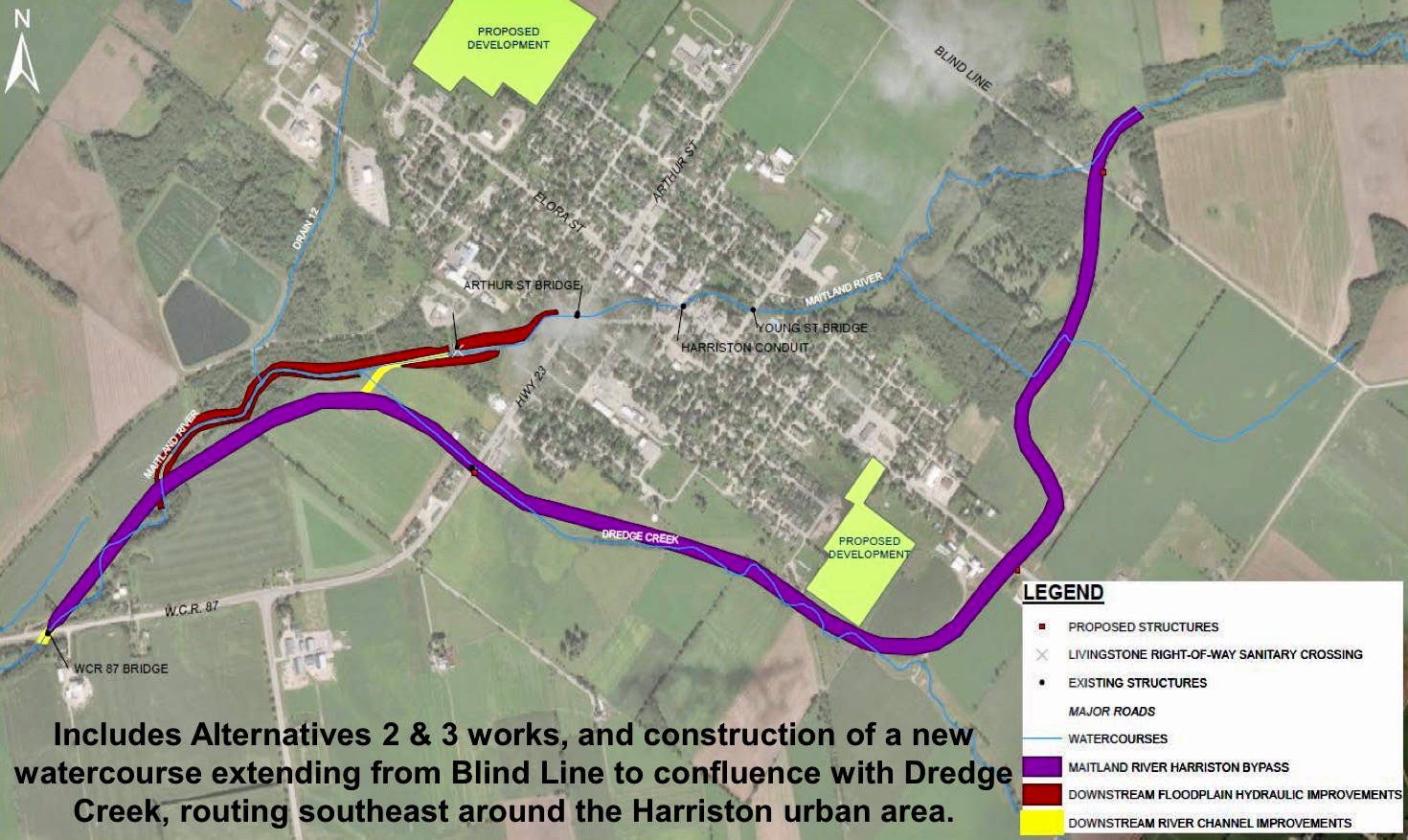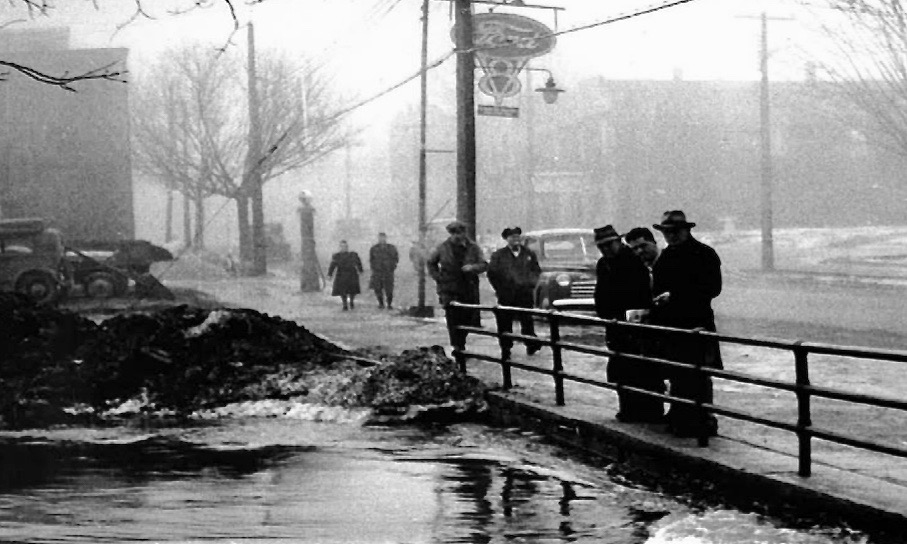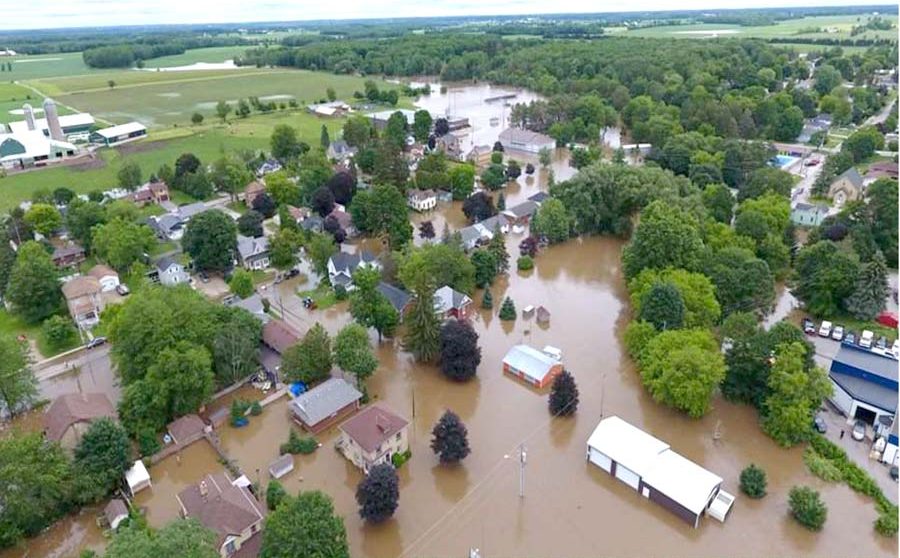MINTO – Redirecting the Maitland River around Harriston is the ultimate long-term solution to flooding problems in the town, states a major report that recommends working in stages to complete and fund the $38-million project over the next two decades.
The final report on the Harriston Flood Mitigation Study, which has been in development since a one-in-100 year flood struck the community in June of 2017, was presented at a meeting of Minto town council on Jan. 26.
The report, compiled at a cost of $50,000, noted that at least 15 documented floods have occurred over the community’s history, dating back to the mid-1800s.
The stated goal of the study is to “Provide practical corrective actions through realistic financial strategies that the Town of Minto and partners can complete in 20 years or less to meaningfully increase public safety and reduce or eliminate property damage caused by riverine (over the banks) flooding in the Harriston Sub-Watershed of the Maitland River.
The report was outlined by Triton Engineering senior planner and former Minto CAO Bill White during the videoconference meeting.
With the majority of residences and businesses in Harriston built within the floodplain, bridges at Young, Elora and Arthur restrict flow through the urban centre during major storm events, causing water levels to rise very quickly, the report explains.
With the Maitland Valley Conservation Authority reporting the amount and intensity of rainfall events increasing in recent years, White noted there is an urgency to correct the problems in Harriston.
Flood risk increases around the town when significant rainfall or snowmelt occurs over a short time and soil is saturated, White told council.
Compounding the problem is that within the 20km stretch known as the Harriston sub-watershed, the river drops in elevation from 85 feet at Wellington Road 6 near Mount Forest, to 15 feet passing through Harriston.
“Half of the watershed is in Wellington North,” noted White. “What you have is a fairly broad area in Wellington North draining very quickly to the county road and at much slower speeds and elevations in Harriston.”
White added, “Over the years we’ve kind of talked about Harriston being at the bottom of the bathtub.
“So water rushes out of Wellington North and it slows down and backs up in Harriston and that’s kind of the physical conditions that make it prone to flooding in that area.”
About 10 flood mitigation scenarios studied in earlier versions of the report have been streamlined into five alternatives for the final report.
White explained that alternative one, which is to “do nothing,” is considered a baseline for comparison with other alternatives.
Alternative two involves floodplain hydraulic improvements downstream of Harriston, including removal of trees and dredge spoilage left from work on the river channel in the 1950s. This work could be done over the next five years at a projected cost of about $2.1 million.
Alternative three includes the work from alternative two plus downstream river channel improvements, such as rerouting, deepening and widening the channel, which could be accomplished over 10 years for around $4.5 million.
Alternative four, improvements to the river channel through Harriston, was dismissed due to lack of potential benefit compared to other scenarios.
Alternative five would see a Maitland River Harriston bypass created from the Blind Line northeast of Harriston to connect with Dredge Creek, just southeast of town. The diverted river would reconnect with the existing Maitland channel at a point beyond the sewage lagoons west of town.
The estimated capital cost of the river diversion alternative would be $38.1 million over 20 years.

A concept rendering showing how the Maitland River could be re-routed around Harriston, from the Blind Line to Dredge Creek, to prevent future flooding. (Minto council package image)
While noting financial aspects of the project require “further evaluation,” White said, “The idea is to phase this work and to do it so there’s partnerships involved, so there is a realistic funding approach.”
White noted the phased approach allows smaller projects which can be integrated into the overall plan to proceed before committing fully to the major river diversion component.
“You can do some work that you can handle financially at the beginning … and that work is not lost,” he explained.
“You can build upon that over time and over the years and if council does choose to move to the full recommended alternative five strategy … nothing is lost by doing the other alternatives first.
Alternative five would completely eliminate Harriston’s urban areas from the flood zone, even in the event of another one-in-a-hundred year flood, said Chris Clark of Triton Engineering.
“If the town of Harriston were to experience a similar event and we had those controls in place … we would have no riverine flooding in Harriston, overtop of the banks, through the town,” Clark stated.
White noted that alternative two, while only a $2.1 million project, “is still very large by town standards.” He projected that work could be completed “within hopefully five years.”
However, he added, “that would obviously be a decision of council through the Drainage Act process.
White also noted “the town would likely have to carry a lot of that cost.”
Work under alternative three, at a cost of around $4.5 million, could be completed within 10 years, the report estimates, although White noted a Class Environmental Assessment process would be required.
White stressed that all costs in the report should be considered “estimates” as figures can change “when you’re talking about a period over 10 years.”
White said the town would need to review progress on the study annually at budget meetings and work with senior levels of government for funding.
He was optimistic about the prospects of provincial funding for projects of this nature.
“I think the province has come to the point where they don’t like paying out after the fact to compensate people and they’d maybe like to be more proactive,” he said.
“Whether that energy carries on, we’ll see. The world has changed a lot in the last year.”
White added, “Alternative five is only achievable with, I’m thinking, in the area of 65 to 70 per cent funding from the province and the federal government,” said White.
White suggested the town would be wise to start putting money annually in a budget reserve toward its contribution to alternative five.
“And there are other ways of getting funding,” White noted. “Obviously the county would be involved because we’re talking about bridges over (Wellington Road) 109 if we do choose to go to the alternative five.
Noting half the watershed is within Wellington North, he wondered if that township would be willing to help with the project.
“There’s opportunities at levying charges at other people who are benefiting from this, like through the municipal drain process, there’s developer contributions … there are a range of ideas and opportunities that your CAO and your treasurer and deputy treasurer can work with you on as far as trying to fund this over the long term,” stated White.
He pointed out local residents expressed an urgent desire to see the problem dealt with at a public meeting held after the 2017 flood.
“People wanted to see things happen and I guess my worst fear is that … we spend a year or two here doing technical work and if something else were to happen and another flood were to occur …”
Minto roads and drainage foreman Mike McIsaac pointed out the town applied in December for assistance through the latest round of National Disaster Mitigation Program for funding to prepare final designs for the mitigation work on the section of the Maitland River west of Harriston.
If grant funds are received, he noted the work would also “help with coming up with a more accurate estimate for all of these, kind of bite-sized projects along the way.”

There have been at least 15 documented floods, including this one in 1948, in Harriston’s history, dating back to the mid-1800s. (Harriston Historical Society photo)
McIsaac said staff will be bringing recommendations on how to proceed to next council meeting.
Councillor Ron Elliott asked if development charges could be used to help pay for any of the flood mitigation work.
White replied that “the Development Charges Act could be used,” however that would require the town to update its development charges bylaw to account for the work.
“That’s a good question and we’ll put that into the bin as we go forward on how we might want to pay for this,” said Mayor George Bridge.
He noted the study “is something we had to do.
“We had to get to this point and I think now the next step is we take it back and work further, in more detail, on some aspects, like the funding,” the mayor stated.
Bridge said he believes the federal government “is tired of putting a Band-Aid on the problem,” which he said goes beyond the financial ramifications of a flood.
“It’s not just the financial cost. It’s losing all your history and your home and everything else. It’s a very traumatic situation when you’re flooded out,” he stated.
“It always seems like a big number, but we have to start somewhere and I like the staged approach.”
Deputy mayor Dave Turton asked if local farmers whose land might be impacted by the project, consulted.
“They know of the work,” said White. “I think that they would like to see flooding reduced and they’re prepared to talk to council about how these alternatives two and three might happen.
“But you’d need to have a final agreement with them that dictated the terms by which the town could go on their property, what restoration would be done and what compensation, if any, would be given to them.”
Noting “quite often too many reports accumulate dust,” Turton said he believes council should move to get the projects going.
“I’m with deputy mayor Turton. I don’t want this sitting on a shelf getting dusty … we have to act on some of this,” said Bridge.
Council accepted the report as information.




